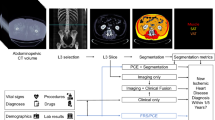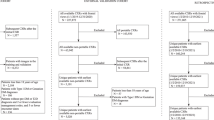Abstract
Opportunistic computed tomography (CT) analysis is a paradigm where CT scans that have already been acquired for routine clinical questions are reanalyzed for disease prognostication, typically aided by machine learning. While such techniques for opportunistic use of abdominal CT scans have been implemented for assessing the risk of a handful of individual disorders, their prognostic power in simultaneously assessing multiple chronic disorders has not yet been evaluated. In this retrospective study of 9,154 patients, we demonstrate that we can effectively assess 5-year incidence of chronic kidney disease (CKD), diabetes mellitus (DM), hypertension (HT), ischemic heart disease (IHD), and osteoporosis (OST) using single already-acquired abdominal CT scans. We demonstrate that a shared multi-planar CT input, consisting of an axial CT slice occurring at the L3 vertebral level, as well as carefully selected sagittal and coronal slices, enables accurate future disease incidence prediction. Furthermore, we demonstrate that casting this shared CT input into a multi-task approach is particularly valuable in the low-label regime. With just 10% of labels for our diseases of interest, we recover nearly 99% of fully supervised AUROC performance, representing an improvement over single-task learning.
Access this chapter
Tax calculation will be finalised at checkout
Purchases are for personal use only
Similar content being viewed by others
References
Chartbook and charts. https://www.cms.gov/Research-Statistics-Data-and-Systems/Statistics-Trends-and-Reports/Chronic-Conditions/Chartbook_Charts
Noncommunicable diseases. https://www.who.int/health-topics/noncommunicable-diseases
Chronic kidney disease in the united states, 2021, March 2021. https://www.cdc.gov/kidneydisease/publications-resources/ckd-national-facts.html
Facts about hypertension, September 2021. https://www.cdc.gov/bloodpressure/
Heart disease facts, February 2022. https://www.cdc.gov/heartdisease/facts.htm
National diabetes statistics report, January 2022. https://www.cdc.gov/diabetes/data/statistics-report/index.html
Bangalore, S., Maron, D.J., Hochman, J.S.: Evidence-based management of stable ischemic heart disease. JAMA 314(18), 1917 (2015). https://doi.org/10.1001/jama.2015.11219
Boutin, R.D., Houston, D.K., Chaudhari, A.S., Willis, M.H., Fausett, C.L., Lenchik, L.: Imaging of sarcopenia. Radiol. Clin. North Am. 60(4), 575–582 (2022). https://doi.org/10.1016/j.rcl.2022.03.001
Boutin, R.D., Lenchik, L.: Value-added opportunistic CT: insights into osteoporosis and sarcopenia. Am. J. Roentgenol. 215(3), 582–594 (2020). https://doi.org/10.2214/ajr.20.22874
Charlson, M.E., Charlson, R.E., Peterson, J.C., Marinopoulos, S.S., Briggs, W.M., Hollenberg, J.P.: The Charlson comorbidity index is adapted to predict costs of chronic disease in primary care patients. J. Clin. Epidemiol. 61(12), 1234–1240 (2008). https://doi.org/10.1016/j.jclinepi.2008.01.006
Clynes, M.A., Harvey, N.C., Curtis, E.M., Fuggle, N.R., Dennison, E.M., Cooper, C.: The epidemiology of osteoporosis. Br. Med. Bull. (2020). https://doi.org/10.1093/bmb/ldaa005
Cohen, J.P., et al.: Gifsplanation via latent shift: a simple autoencoder approach to progressive exaggeration on chest x-rays. CoRR abs/2102.09475 (2021). https://arxiv.org/abs/2102.09475
Dagan, N., et al.: Automated opportunistic osteoporotic fracture risk assessment using computed tomography scans to aid in FRAX underutilization. Nat. Med. 26(1), 77–82 (2020). https://doi.org/10.1038/s41591-019-0720-z
Rijken, M., Van Kerkhof, M., Dekker, J., Schellevis, F.G.: Comorbidity of chronic diseases: effects of disease pairs on physical and mental functioning. https://pubmed.ncbi.nlm.nih.gov/15789940/
Fifty, C., Amid, E., Zhao, Z., Yu, T., Anil, R., Finn, C.: Efficiently identifying task groupings for multi-task learning. CoRR abs/2109.04617 (2021). https://arxiv.org/abs/2109.04617
Finn, C., Abbeel, P., Levine, S.: Model-agnostic meta-learning for fast adaptation of deep networks. In: Precup, D., Teh, Y.W. (eds.) Proceedings of the 34th International Conference on Machine Learning. Proceedings of Machine Learning Research, vol. 70, pp. 1126–1135. PMLR, 06–11 August 2017. https://proceedings.mlr.press/v70/finn17a.html
He, K., Zhang, X., Ren, S., Sun, J.: Deep residual learning for image recognition. CoRR abs/1512.03385 (2015). http://arxiv.org/abs/1512.03385
Higgins, T.: Hba1c for screening and diagnosis of diabetes mellitus. Endocrine 43(2), 266–273 (2012). https://doi.org/10.1007/s12020-012-9768-y
Kanavati, F., Islam, S., Arain, Z., Aboagye, E.O., Rockall, A.: Fully-automated deep learning slice-based muscle estimation from CT images for sarcopenia assessment (2020)
Kingma, D.P., Ba, J.: Adam: a method for stochastic optimization (2014). https://doi.org/10.48550/ARXIV.1412.6980, https://arxiv.org/abs/1412.6980
LaVallee, L.A., Scott, M.A., Hulkower, S.D.: Challenges in the screening and management of osteoporosis. North Carol. Med. J. 77(6), 416–419 (2016). https://doi.org/10.18043/ncm.77.6.416
Liu, C.T., et al.: Visceral adipose tissue is associated with bone microarchitecture in the Framingham osteoporosis study. J. Bone Mineral Res. 32(1), 143–150 (2017). https://doi.org/10.1002/jbmr.2931, https://asbmr.onlinelibrary.wiley.com/doi/abs/10.1002/jbmr.2931
Manzano, W., Lenchik, L., Chaudhari, A.S., Yao, L., Gupta, S., Boutin, R.D.: Sarcopenia in rheumatic disorders: what the radiologist and rheumatologist should know. Skeletal Radiol. 51(3), 513–524 (2021). https://doi.org/10.1007/s00256-021-03863-z
Martin, A.B., Hartman, M., Lassman, D., Catlin, A.: National health care spending in 2019: steady growth for the fourth consecutive year. Health Aff. 40(1), 14–24 (2021). https://doi.org/10.1377/hlthaff.2020.02022
Mettler, F.A., et al.: Patient exposure from radiologic and nuclear medicine procedures in the united states: procedure volume and effective dose for the period 2006–2016 (2020)
Pfohl, S., Marafino, B.J., Coulet, A., Rodriguez, F., Palaniappan, L., Shah, N.H.: Creating fair models of atherosclerotic cardiovascular disease risk. CoRR abs/1809.04663 (2018). http://arxiv.org/abs/1809.04663
Pickhardt, P.J., et al.: Automated CT biomarkers for opportunistic prediction of future cardiovascular events and mortality in an asymptomatic screening population: a retrospective cohort study. Lancet Digit. Health 2(4) (2020). https://doi.org/10.1016/s2589-7500(20)30025-x
Reginster, J.Y., Beaudart, C., Buckinx, F., Bruyère, O.: Osteoporosis and sarcopenia. Curr. Opin. Clin. Nutr. Metab. Care 19(1), 31–36 (2016). https://doi.org/10.1097/mco.0000000000000230
Standley, T., Zamir, A.R., Chen, D., Guibas, L.J., Malik, J., Savarese, S.: Which tasks should be learned together in multi-task learning? CoRR abs/1905.07553 (2019). http://arxiv.org/abs/1905.07553
Zambrano Chaves, J.M., et al.: Opportunistic assessment of ischemic heart disease risk using abdominopelvic computed tomography and medical record data: a multimodal explainable artificial intelligence approach. medRxiv (2021). https://doi.org/10.1101/2021.01.23.21250197, https://www.medrxiv.org/content/early/2021/01/26/2021.01.23.21250197
Zamir, A.R., Sax, A., Shen, W.B., Guibas, L.J., Malik, J., Savarese, S.: Taskonomy: disentangling task transfer learning. CoRR abs/1804.08328 (2018). http://arxiv.org/abs/1804.08328
Author information
Authors and Affiliations
Corresponding author
Editor information
Editors and Affiliations
1 Electronic supplementary material
Below is the link to the electronic supplementary material.
Rights and permissions
Copyright information
© 2022 The Author(s), under exclusive license to Springer Nature Switzerland AG
About this paper
Cite this paper
Blankemeier, L. et al. (2022). Opportunistic Incidence Prediction of Multiple Chronic Diseases from Abdominal CT Imaging Using Multi-task Learning. In: Wang, L., Dou, Q., Fletcher, P.T., Speidel, S., Li, S. (eds) Medical Image Computing and Computer Assisted Intervention – MICCAI 2022. MICCAI 2022. Lecture Notes in Computer Science, vol 13437. Springer, Cham. https://doi.org/10.1007/978-3-031-16449-1_30
Download citation
DOI: https://doi.org/10.1007/978-3-031-16449-1_30
Published:
Publisher Name: Springer, Cham
Print ISBN: 978-3-031-16448-4
Online ISBN: 978-3-031-16449-1
eBook Packages: Computer ScienceComputer Science (R0)





